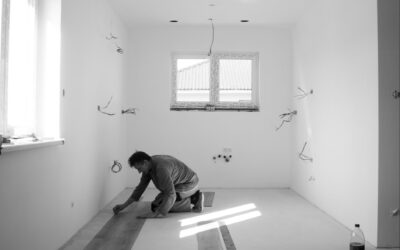LVT flooring is especially versatile in terms of installation and in most cases, providing there is a solid subfloor, nothing else is needed. But what if you have an existing LVT floor that is looking a little tired or dated and you want to upgrade it with a fresh new set of tiles?
Can you lay LVT on top of LVT and save yourself a heap of time and effort, or does the old LVT have to be removed? This is what I discuss in the below article, and I want to start by saying that it is possible!
Understanding Luxury Vinyl Tile (LVT)
Luxury Vinyl Tile Flooring is currently one of the most popular flooring types due to its versatility. It’s durable, water-resistant, comfortable to walk on, and available in an epic range of colours and styles. You can essentially mimic hardwood and stone floors for a fraction of the cost.
The tiles are made from multiple layers with the core component being vinyl. Other layers include transparent protective ones on the top, underlay, and a durable core that provides most of the stability. Indeed, rigid core luxury vinyl flooring has a thicker central core that makes the flooring even more durable.
For installation, LVT flooring is most commonly laid onto a solid and level subfloor such as chipboard, plywood, or even floorboards. However, providing that the floor is stable and level, it can be installed over other materials, including crucially, existing vinyl floor tiles.
Pros and Cons of Layering LVT
LVT can be laid on old LVT, but it does have pros and cons and you must understand these before making your decision.
Pros
- Quick installation: LVT flooring is especially quick to install even without the added bonus of not having to prepare a subfloor. However, by laying your new LVT over the old floor, you are saving a heap of work and effort. Yes, the old flooring must be prepared, but that’s a small task compared to potentially installing an entirely new subfloor.
- Cost-effective: By laying LVT over LVT you are cutting out the extra expense of paying for someone to take up your old floor if you can’t do it yourself. There is so course no need to pay for new subfloor materials either.
- Great end results: If the old LVT is in great condition and you have a stable subfloor, your new LVT flooring will look superb! No one will ever be able to tell that there is a layer of LVT underneath and you can bask in the glory of your stylish new floor.
Cons
- No subfloor analysis: LVT works best when it is installed on a solid, even subfloor such as plywood or chipboard. If you have an existing layer of LVT you cannot check the quality of the subfloor beneath and thus could potentially be hiding damage and things that could cause issues in the future.
Adhesive problems: Glue-down LVT sticks the tiles to your subfloor using an adhesive and this can be affected by imperfections in the old LVT. For example, if there are cracks or extensive damage, the adhesive simply might not work or you may get movement and instability once the tiles are installed.
Before You Start Installing LVT over LVT
We have established that you can lay LVT over LVT, but you must assess the quality of your existing LVT, think about the subfloor underneath, and make sure it is prepared to accept the new layer of LVT flooring.
Current vinyl quality assessment
Hopefully, your existing vinyl flooring has been installed over a solid, good-quality subfloor. As mentioned, this is a drawback as without taking up the LVT (which you want to avoid), you can’t check the subfloor.
Therefore, all you can do is check the quality of the existing LVT and look for cracks, chips, and damage. Laying LVT onto damaged LVT could cause instability or adhesive problems.
Preparing the existing vinyl
So that the new LVT flooring can be installed you must also prepare the old tiles. Make sure that they are clean and free from dirt and grime as this can reduce the effectiveness of adhesive (if you are using glue-down LVT).
Also, check the levelling of the old floor. Ideally, there shouldn’t be any deviation and if there is, you may need to use a levelling screed before installing the new tiles.
LVT Flooring Can be Installed Over Virtually Any Subfloor
So, can you lay LVT on top of LVT? Yes!
This is why LVT is so popular because compared to flooring like carpets or hardwood floors, it offers greater flexibility and is typically easier to install. This shouldn’t be done without caution and pre-planning though and it’s always important to check the manufacturer’s instructions and any manufacturer’s warranty guidelines.









